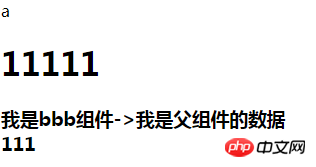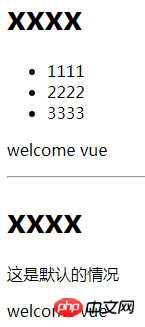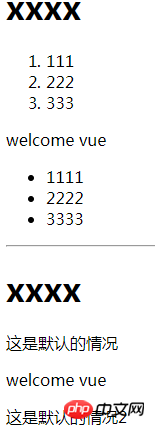 Web Front-end
Web Front-end
 JS Tutorial
JS Tutorial
 Detailed explanation of vue.js data transfer and data distribution slot examples
Detailed explanation of vue.js data transfer and data distribution slot examples
Detailed explanation of vue.js data transfer and data distribution slot examples
This article mainly analyzes the relevant knowledge of vue.js data transfer and data distribution slot through code examples. Friends who are interested in this aspect can refer to it. I hope it can help everyone.
1. Data transfer between components
1. The parent component obtains the data of the child component
*The child component transfers its own data , sent to the parent
*vm.$emit(event name, data);
*v-on: @
Example usage: when the send button is clicked , "111" becomes "I am the data of the child component"
<!DOCTYPE html>
<html lang="en">
<head>
<meta charset="UTF-8">
<title>父级获取子级的数据</title>
<script src="bower_components/vue/dist/vue.js"></script>
<style>
</style>
</head>
<body>
<p>
<aaa>
</aaa>
</p>
<template>
<span>我是父级 -> {{msg}}</span>
//自动调用get方法,@child-msg和下面的this.$emit('child-msg',this.a)相对应
<bbb @child-msg="get"></bbb>
</template>
<template>
<h3>子组件-</h3>
<input type="button" value="send" @click="send">
</template>
<script>
var vm=new Vue({
el:'#box',
data:{
a:'aaa'
},
components:{
'aaa':{
data:function(){
return {
msg:111,
msg2:'我是父组件的数据'
}
},
template:'#aaa',
methods:{
//这里的msg实际上就是子组件传递给父组件的数据
get:function(msg){
this.msg=msg;
}
},
components:{
'bbb':{
data:function(){
return {
a:'我是子组件的数据'
}
},
template:'#bbb',
methods:{
send:function(){
this.$emit('child-msg',this.a);
}
}
}
}
}
}
});
</script>
</body>
</html>2. The child component obtains the data of the parent component
When calling the child component:
Within subcomponent:
props:['m','myMsg']
props:{
'm':String,
'myMsg':Number
}<!DOCTYPE html>
<html lang="en">
<head>
<meta charset="UTF-8">
<title>自己获取父级的数据</title>
<script src="bower_components/vue/dist/vue.js"></script>
<style>
</style>
</head>
<body>
<p>
<p>{{a}}</p>
<aaa>
{{msg}}
</aaa>
</p>
<template>
<h1>11111</h1>
<bbb :mmm="msg2" :my-msg="msg"></bbb>
</template>
<script>
var vm=new Vue({
el:'#box',
data:{
a:'a'
},
components:{
'aaa':{
data:function(){
return {
msg:111,
msg2:'我是父组件的数据'
}
},
template:'#aa',
components:{
'bbb':{
props:{
'mmm':String,
'myMsg':Number
},
template:'<h3>我是bbb组件->{{mmm}} <br> {{myMsg}}</h3>'
}
}
}
}
});
</script>
</body>
</html>Run result:

2. Content distribution:
Vue.js provides a way to mix the content of the parent component and the template of the child component itself: slot, used to occupy a position
1. Basic usage
<!DOCTYPE html>
<html lang="en">
<head>
<meta charset="UTF-8">
<title>slot保留原来的位置</title>
<script src="bower_components/vue/dist/vue.js"></script>
<style>
</style>
</head>
<body>
<p>
<aaa>
<ul>
<li>1111</li>
<li>2222</li>
<li>3333</li>
</ul>
</aaa>
<hr>
<aaa>
</aaa>
</p>
<template>
<h1>xxxx</h1>
<slot>这是默认的情况</slot>
<p>welcome vue</p>
</template>
<script>
var vm=new Vue({
el:'#box',
data:{
a:'aaa'
},
components:{
'aaa':{
template:'#aaa'
}
}
});
</script>
</body>
</html>Running result: The content in the ul tag is not overwritten. If slot is not used, the content in the ul tag will be overwritten

2. The name attribute of the slot
<!DOCTYPE html>
<html lang="en">
<head>
<meta charset="UTF-8">
<title>slot中name属性的使用</title>
<script src="bower_components/vue/dist/vue.js"></script>
<style>
</style>
</head>
<body>
<p>
<aaa>
<ul slot="ul-slot"> //这里slot的名字要与下面slot中name属性相对应
<li>1111</li>
<li>2222</li>
<li>3333</li>
</ul>
<ol slot="ol-slot"> //用法同上
<li>111</li>
<li>222</li>
<li>333</li>
</ol>
</aaa>
<hr>
<aaa>
</aaa>
</p>
<template>
<h1>xxxx</h1>
<slot name="ol-slot">这是默认的情况</slot> //设置name属性,给slot命名
<p>welcome vue</p>
<slot name="ul-slot">这是默认的情况2</slot>
</template>
<script>
var vm=new Vue({
el:'#box',
data:{
a:'aaa'
},
components:{
'aaa':{
template:'#aaa'
}
}
});
</script>
</body>
</html>Running results:

Related recommendations:
How to transfer data between vue.js components
The above is the detailed content of Detailed explanation of vue.js data transfer and data distribution slot examples. For more information, please follow other related articles on the PHP Chinese website!

Hot AI Tools

Undresser.AI Undress
AI-powered app for creating realistic nude photos

AI Clothes Remover
Online AI tool for removing clothes from photos.

Undress AI Tool
Undress images for free

Clothoff.io
AI clothes remover

Video Face Swap
Swap faces in any video effortlessly with our completely free AI face swap tool!

Hot Article

Hot Tools

Notepad++7.3.1
Easy-to-use and free code editor

SublimeText3 Chinese version
Chinese version, very easy to use

Zend Studio 13.0.1
Powerful PHP integrated development environment

Dreamweaver CS6
Visual web development tools

SublimeText3 Mac version
God-level code editing software (SublimeText3)

Hot Topics
 1653
1653
 14
14
 1413
1413
 52
52
 1304
1304
 25
25
 1251
1251
 29
29
 1224
1224
 24
24
 How to implement an online speech recognition system using WebSocket and JavaScript
Dec 17, 2023 pm 02:54 PM
How to implement an online speech recognition system using WebSocket and JavaScript
Dec 17, 2023 pm 02:54 PM
How to use WebSocket and JavaScript to implement an online speech recognition system Introduction: With the continuous development of technology, speech recognition technology has become an important part of the field of artificial intelligence. The online speech recognition system based on WebSocket and JavaScript has the characteristics of low latency, real-time and cross-platform, and has become a widely used solution. This article will introduce how to use WebSocket and JavaScript to implement an online speech recognition system.
 WebSocket and JavaScript: key technologies for implementing real-time monitoring systems
Dec 17, 2023 pm 05:30 PM
WebSocket and JavaScript: key technologies for implementing real-time monitoring systems
Dec 17, 2023 pm 05:30 PM
WebSocket and JavaScript: Key technologies for realizing real-time monitoring systems Introduction: With the rapid development of Internet technology, real-time monitoring systems have been widely used in various fields. One of the key technologies to achieve real-time monitoring is the combination of WebSocket and JavaScript. This article will introduce the application of WebSocket and JavaScript in real-time monitoring systems, give code examples, and explain their implementation principles in detail. 1. WebSocket technology
 How to use JavaScript and WebSocket to implement a real-time online ordering system
Dec 17, 2023 pm 12:09 PM
How to use JavaScript and WebSocket to implement a real-time online ordering system
Dec 17, 2023 pm 12:09 PM
Introduction to how to use JavaScript and WebSocket to implement a real-time online ordering system: With the popularity of the Internet and the advancement of technology, more and more restaurants have begun to provide online ordering services. In order to implement a real-time online ordering system, we can use JavaScript and WebSocket technology. WebSocket is a full-duplex communication protocol based on the TCP protocol, which can realize real-time two-way communication between the client and the server. In the real-time online ordering system, when the user selects dishes and places an order
 How to implement an online reservation system using WebSocket and JavaScript
Dec 17, 2023 am 09:39 AM
How to implement an online reservation system using WebSocket and JavaScript
Dec 17, 2023 am 09:39 AM
How to use WebSocket and JavaScript to implement an online reservation system. In today's digital era, more and more businesses and services need to provide online reservation functions. It is crucial to implement an efficient and real-time online reservation system. This article will introduce how to use WebSocket and JavaScript to implement an online reservation system, and provide specific code examples. 1. What is WebSocket? WebSocket is a full-duplex method on a single TCP connection.
 JavaScript and WebSocket: Building an efficient real-time weather forecasting system
Dec 17, 2023 pm 05:13 PM
JavaScript and WebSocket: Building an efficient real-time weather forecasting system
Dec 17, 2023 pm 05:13 PM
JavaScript and WebSocket: Building an efficient real-time weather forecast system Introduction: Today, the accuracy of weather forecasts is of great significance to daily life and decision-making. As technology develops, we can provide more accurate and reliable weather forecasts by obtaining weather data in real time. In this article, we will learn how to use JavaScript and WebSocket technology to build an efficient real-time weather forecast system. This article will demonstrate the implementation process through specific code examples. We
 Simple JavaScript Tutorial: How to Get HTTP Status Code
Jan 05, 2024 pm 06:08 PM
Simple JavaScript Tutorial: How to Get HTTP Status Code
Jan 05, 2024 pm 06:08 PM
JavaScript tutorial: How to get HTTP status code, specific code examples are required. Preface: In web development, data interaction with the server is often involved. When communicating with the server, we often need to obtain the returned HTTP status code to determine whether the operation is successful, and perform corresponding processing based on different status codes. This article will teach you how to use JavaScript to obtain HTTP status codes and provide some practical code examples. Using XMLHttpRequest
 How to get HTTP status code in JavaScript the easy way
Jan 05, 2024 pm 01:37 PM
How to get HTTP status code in JavaScript the easy way
Jan 05, 2024 pm 01:37 PM
Introduction to the method of obtaining HTTP status code in JavaScript: In front-end development, we often need to deal with the interaction with the back-end interface, and HTTP status code is a very important part of it. Understanding and obtaining HTTP status codes helps us better handle the data returned by the interface. This article will introduce how to use JavaScript to obtain HTTP status codes and provide specific code examples. 1. What is HTTP status code? HTTP status code means that when the browser initiates a request to the server, the service
 JavaScript and WebSocket: Building an efficient real-time image processing system
Dec 17, 2023 am 08:41 AM
JavaScript and WebSocket: Building an efficient real-time image processing system
Dec 17, 2023 am 08:41 AM
JavaScript is a programming language widely used in web development, while WebSocket is a network protocol used for real-time communication. Combining the powerful functions of the two, we can create an efficient real-time image processing system. This article will introduce how to implement this system using JavaScript and WebSocket, and provide specific code examples. First, we need to clarify the requirements and goals of the real-time image processing system. Suppose we have a camera device that can collect real-time image data



